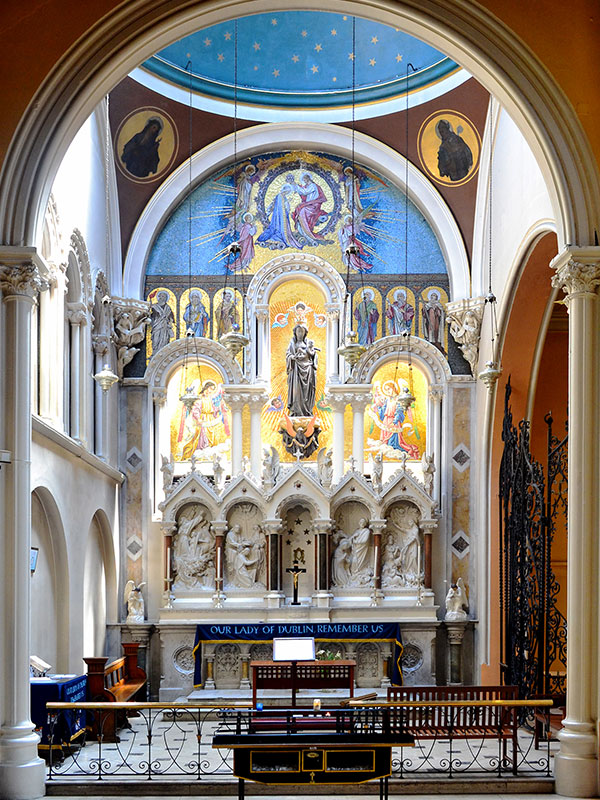A Brief History
It was in 1279 that the Carmelite friars first came to what is one of the oldest parts of Dublin. They sought to serve God’s people in the midst of the city and flourished for well over two hundred years until the church and priory were dispossessed in 1539 as part of the Dissolution of Monasteries. The present church and priory was set up in 1825 and expanded and reordered several times until in the 1950’s it took the shape we know today. Over time the church’s interior has been beautifully furnished with various artworks including statues, mosaics, paintings, and stained-glass, in many cases drawing on the skills of local craft workers. All of this is intended to nourish the spiritual lives of those who come here and to inspire the worshipping community who gather. In 1983 the church’s famous Kenneth Jones pipe organ was installed and, in addition to serving the musical needs of the liturgy, has contributed greatly to the cultural life of Dublin with concerts and recitals being regularly held.
The relics of St Valentine were gifted to the church in 1835 by Pope Gregory XVI. They were entrusted to Carmelite, Fr John Spratt, who visited Rome in 1835 and preached at one of the most prestigious churches there. The relics were installed at Whitefriar Street on 10th November 1836. Gifting the relics of St Valentine, a saint from ancient Rome and from the earliest days of Christianity, was a way for the Pope to lend support to Catholics in Dublin who had gone through a period of oppression. St Valentine is the patron saint of love on account of his willingness to marry couples in defiance of the wishes of the Roman Emperor who wanted young men to commit to his war efforts. St Valentine’s shrine at Whitefriar Street is ever popular with visitors.
The Shrine of Our Lady of Dublin is to be found in Whitefriar Street Church and is a place of peace and reflection. Originally the black oak statue stood in a place of honour in St Mary’s Abbey, Mary Street (the site is now occupied by St Michan’s flats). Recently a portion of the old abbey has been restored and is accessible through Meeting House Lane off Capel Street.
The statue of Our Lady of Dublin with the Christ child is of fifteenth-century origin and, after the sacking of the Abbey in 1539, was hidden and preserved. It was found by Fr Spratt in 1824 and brought to Whitefriar Street Church. The history of its survival is indicative of the persevering faith of the people and the statue is held dear by Dubliners to this day. The feast day of Our Lady of Dublin is celebrated on 8th September each year which is also the date of the Birthday of Our Lady.
There are many other shrines at Whitefriar Street where candles burn continuously, representing people’s prayers. In the main entrance area is a Calvary scene as well as the Shrine of St Albert of Sicily from where people may avail of ‘St Albert’s Water’.

There is a Coffee Shop located within the church’s buildings where visitors can enjoy refreshment. Along the walkway between the coffee shop and the main church there is a display on the Carmelite Order which includes photographs and texts about the original Carmelite foundation in Israel, the history of the Irish Carmelite Province, and the work of the Carmelites in Zimbabwe. As one enters the church by the main entrance on Aungier Street there is a display on the history of the church itself. Just off the main entrance area there is a repository shop which is well stocked with Mass cards, pictures, prayer cards, and rosaries.
The Carmelite Community Centre on Aungier Street, just along from the church entrance, was officially opened by President of Ireland, Mary McAleese, in 1998 and seeks to serve the needs of local people as well as having a wider outreach. The centre and its various services and projects have received many awards in recognition of the vital contribution they make.


